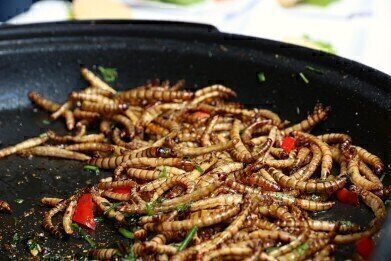Environmental Laboratory
How Mealworms Can Reduce Plastic Pollution
Jan 13 2020
A new study from the University of Stanford in the USA has given researchers cause for optimism that mealworms could hold part of the solution to the world's escalating microplastics problem. Led by PhD candidate Anja Malawi Brandon, the team found that the tiny larvae are capable of consuming various different types of plastic with no adverse consequences to their health.
Not only that, but the research also concluded that mealworms are able to eat Styrofoam which contains environmentally damaging chemicals without affecting either their own health or that of the animals who feed upon their protein-rich bodies after the fact. As such, the study represents a promising method of turning our almost ubiquitous plastic waste into a beneficial resource.
Carrying on from previous works
Mealworms are simple creatures which are easy to farm and provide a bountiful source of protein for all kinds of other animals, from chickens to crustaceans. Previous research carried out at Stanford made the discovery that mealworms are able to survive and indeed thrive on a diet comprised of a number of different kinds of plastic, due to microorganisms inside their gut which break the plastic down.
Despite the encouraging conclusions of those studies, it remained unclear whether the chemicals inside the plastic would build up inside the bodies of the mealworms over time, thus rendering them unsafe for larger animals to eat after their death. The latest study, published in the journal Environmental Science and Technology, attempted to answer that question.
Feedstock unaffected
Working alongside experienced mealworm researcher Wei-Min Wu, Brandon and the team decided to focus on Styrofoam (a brand of polystyrene) and in particular, on the common chemical additive hexabromocyclododecane (HBCD), which acts a flame retardant. Since almost 25 million metric tonnes of the stuff were added to plastics in 2015 alone, the authors were keen to see how ingesting the substance would affect both mealworms and the animals which feed on their bodies.
Their results showed that 90% of the HBCD was excreted within the first 24 hours after ingestion, with the substance removed from their system altogether within 48 hours. Approximately half of the Styrofoam was emitted as carbon dioxide, while the other half was excreted as miniscule, partially-degraded fragments. Most importantly of all, there was no difference between the health of mealworms fed the Styrofoam as those reared on a normal diet, nor was there any discrepancy between samples of shrimp fed both categories of mealworms after the fact.
Promising results
The conclusions reached by Brandon, Wu and their colleagues signalled that mealworms could comprise part of a multifaceted strategy of removing the billions of tonnes of plastic waste that continue to accumulate in our atmosphere. Other innovative avenues that are being pursued include the unlikely combination of forensic science and artificial intelligence, among others.
However, they were quick to acknowledge that chemicals other than HBCD may have different effects on the health of mealworms and other animals, and that the excretions of the polystyrene were only partially-degraded, meaning the problem has not been solved entirely. “This is a wake-up call,” explained Brandon. “It reminds us that we need to think about what we're adding to our plastics and how we deal with it.”
Digital Edition
IET 34.2 March 2024
April 2024
Gas Detection - Biogas batch fermentation system for laboratory use with automatic gas analysis in real time Water/Wastewater - Upcycling sensors for sustainable nature management - Prist...
View all digital editions
Events
Apr 30 2024 Melbourne, Australia
Apr 30 2024 Birmingham, UK
May 03 2024 Seoul, South Korea
May 05 2024 Seville, Spain
May 06 2024 Minneapolis, MN, USA


















